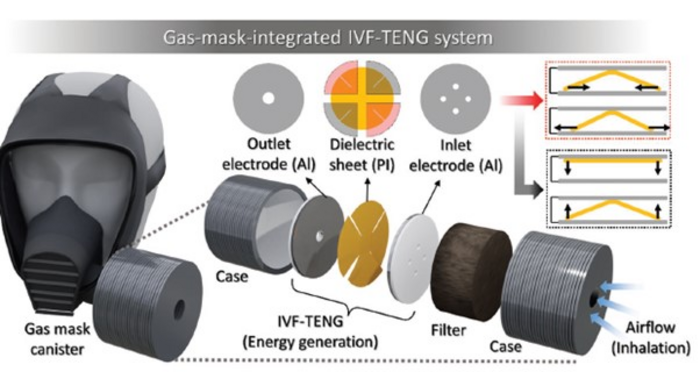With the onset of the Internet of Things (IoT) era, devices have learned to communicate and exchange data. This is achieved through sensors installed in physical objects, machines, and equipment. The sensors can detect changes in events. However, the need for continuous energy supply to these sensors poses a challenge. Batteries are bulky, expensive, and not environmentally friendly. Additionally, they need to be constantly replaced or recharged.

Credit: Prof. Sangmin Lee from Chung-Ang University, Korea
With the onset of the Internet of Things (IoT) era, devices have learned to communicate and exchange data. This is achieved through sensors installed in physical objects, machines, and equipment. The sensors can detect changes in events. However, the need for continuous energy supply to these sensors poses a challenge. Batteries are bulky, expensive, and not environmentally friendly. Additionally, they need to be constantly replaced or recharged.
Consequently, there is a demand for sustainable and renewable energy sources to replace batteries. The triboelectric nanogenerator (TENG) is one such device. Put simply, TENGs convert mechanical energy into electrical energy. Their high energy efficiency, compatibility with readily available materials, and low cost make them a promising candidate for powering sensors.
Despite such advantages, however, current TENGs are limited by a low output current. But increasing the output current would require larger equipment, making it impossible to be used in small devices. Is there a way around this trade-off?
Fortunately, a research team led by Associate Professor Sangmin Lee from Chung-Ang University in Korea, has now addressed this issue. “Our lab is interested in high-power TENG design and TENG-based self-powered sensors. We sought to address the limitation of current TENGs so that they could be used to realize portable power sources in practice,” says Dr. Lee, explaining his motivation behind the study, which was published online on May 31, 2022 in Advanced Energy Materials. The study will be featured on the front cover of the upcoming issue.
The team developed a novel device in their study called “inhalation-driven vertical flutter TENG” (IVF-TENG) which exhibits an amplified current output. “Respiration acts as a continuous mechanical input and can be used to operate TENGs. Film-flutter TENGs are such respiration-driven devices that can generate a continuous electrical output from an extremely small respiration input by exploiting the flutter phenomenon arising from airflow-induced vibrations,” explains Dr. Lee.
The IVF-TENG is composed of an aluminium (Al) inlet electrode, an aeroelastic dielectric sheet (polyimide), and an Al outlet electrode. The aeroelastic sheet has four segments with four slits and is subjected to vertical flutter behavior caused by airflow. This makes the proposed IVF-TENG different from existing TENGs.
The team investigated the electrical and mechanical mechanisms of IVF-TENG. They found that IVF-TENG generated a continuous, high-frequency electrical voltage (17 V) and a closed-circuit current of 1.84 μA during inhalation, and an electrostatic discharge voltage of 456 V and closed-circuit output current of 288 mA at the beginning and end of every inspiratory cycle.
They further demonstrated that IVF-TENG can continuously power 130 LEDs in series and 140 LEDs in parallel in every inhalation. Additionally, it could charge a 660 F capacitor to, in turn, power a Bluetooth tracker and provide its signal to a smartphone. These properties demonstrated the potential for IVF-TENG’s application in portable electronics and wireless data transmission.
Furthermore, the researchers integrated IVF-TENG into a gas mask and demonstrated its ability to monitor the breathing pattern of the user by observing the output response waveform. Moreover, it could detect chemical warfare agents like cyanogen chloride, sarin, and dimethyl methylphosphonate (DMMP), showing its potential for use during emergencies. “Since gas masks are extensively used in emergencies like fire and chemical gas exposure, we focused on applying TENG to a gas mask. We believe that IVF-TENG can be used as a self-powered sensor in such scenarios,” Dr. Lee speculates.
Indeed, their invention could make TENGs reinvent gas masks as a self-powered hybrid sensing system in the near future!
***
Reference
DOI: https://doi.org/10.1002/aenm.202201001
Authors: Deokjae Heo1, Myunghwan Song1, Seh-Hoon Chung1, Kyunghwan Cha1, Youna Kim2, Jihoon Chung2, Patrick T.J. Hwang3, Jaeheon Lee4, Heesoo Jung4, Youngho Jin4, Jinkee Hong2, Min-Kun Kim4, and Sangmin Lee1
Affiliations:
1School of Mechanical Engineering, Chung-Ang University
2Department of Chemical & Biomolecular Engineering, College of Engineering, Yonsei University
3Department of Biomedical Engineering, The University of Alabama at Birmingham
4Agency for Defense Development, Chem-Bio Technology Center
About Chung-Ang University
Chung-Ang University is a private comprehensive research university located in Seoul, South Korea. It was started as a kindergarten in 1916 and attained university status in 1953. It is fully accredited by the Ministry of Education of Korea. Chung-Ang University conducts research activities under the slogan of “Justice and Truth.” Its new vision for completing 100 years is “The Global Creative Leader.” Chung-Ang University offers undergraduate, postgraduate, and doctoral programs, which encompass a law school, management program, and medical school; it has 16 undergraduate and graduate schools each. Chung-Ang University’s culture and arts programs are considered the best in Korea.
Website: https://neweng.cau.ac.kr/index.do
About Associate Professor Sangmin Lee
Dr. Sangmin Lee received his Ph.D. in Mechanical Engineering from Pohang University of Science and Technology (POSTECH) in 2011. He teaches at Chung-Ang University where he is an Associate Professor in the School of Mechanical Engineering. His group researches in the field of energy harvesting based on electrostatic potential, piezoelectric/triboelectric nanogenerators, and hybrid cells. His research interests also lie in surface wetting control including superhydrophobicity/superhydrophilicity based on micro and nanofabrications, and mechanical characterization of micro and nanostructures surfaces.
Read more about Prof. Lee here: https://scholarworks.bwise.kr/cau/researcher-profile?ep=919
Journal
Advanced Energy Materials
DOI
10.1002/aenm.202201001
Method of Research
Experimental study
Subject of Research
Not applicable
Article Title
Inhalation-Driven Vertical Flutter Triboelectric Nanogenerator with Amplified Output as a Gas-Mask-Integrated Self-Powered Multifunctional System
Article Publication Date
31-May-2022
COI Statement
The authors have no conflicts to declare




